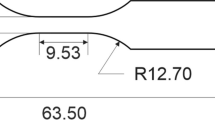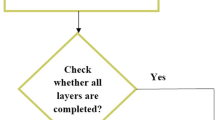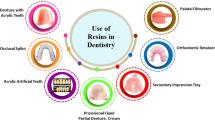Abstract
Additive manufacturing (AM) is a recently developed fabrication technology that allows the development of stronger and lighter components. The aim of this research is to study and examine the influence of various process parameters of masked stereolithography (MSLA) apparatus, namely, exposure time, intensity, and rest time on the tensile strength. The Taguchi design of experiments, L9 orthogonal array, was employed to determine the optimal conditions for printing the RESIONE M58 resin samples. Moreover, the analysis of variance (ANOVA) was utilized to obtain the significance of each parameter of MSLA process on the strength of the samples. According to the experimental results obtained from Taguchi method, the exposure time of 35 to 1.5 s, intensity of 80%, and rest time of 0.5 s were the best conditions for enhancement of the strength of resin. Exposure time was detected as the main factor that can control the tensile strength of 3D-printed samples with the highest significance of ~ 66%. It should be mentioned that the significance of errors or unconsidered items was found around 29%.







Similar content being viewed by others
Data availability
The data underlying this article will be shared on reasonable request to the corresponding author.
References
Zhang, J., Xiao, P.: 3D printing of photopolymers. Polym. Chem. 9, 1530–1540 (2018). https://doi.org/10.1039/C8PY00157J
Bagheri, A., Jin, J.: Photopolymerization in 3D printing. ACS Appl. Polym. Mater. 1, 593–611 (2019). https://doi.org/10.1021/acsapm.8b00165
Thompson, M.K., Moroni, G., Vaneker, T., Fadel, G., Campbell, R.I., Gibson, I., Bernard, A., Schulz, J., Graf, P., Ahuja, B., Martina, F.: Design for additive manufacturing: Trends, opportunities, considerations, and constraints. CIRP Ann. 65, 737–760 (2016). https://doi.org/10.1016/j.cirp.2016.05.004
Attaran, M.: The rise of 3-D printing: The advantages of additive manufacturing over traditional manufacturing. Bus. Horiz. 60, 677–688 (2017). https://doi.org/10.1016/j.bushor.2017.05.011
Kadic, M., Milton, G.W., van Hecke, M., Wegener, M.: 3D metamaterials. Nat. Rev. Phys. 1, 198–210 (2019). https://doi.org/10.1038/s42254-018-0018-y
Zhu, J., Zhou, H., Wang, C., Zhou, L., Yuan, S., Zhang, W.: A review of topology optimization for additive manufacturing: Status and challenges. Chin. J. Aeronaut. 34, 91–110 (2021). https://doi.org/10.1016/j.cja.2020.09.020
Ullah, A.M.M.S., D’Addona, D.M., Harib, K.H., Lin, T.: Fractals and additive manufacturing. Int. J. Autom. Technol. 10, 222–230 (2016). https://doi.org/10.20965/ijat.2016.p0222
Jun, S.Y., Sanz-Izquierdo, B., Parker, E.A., Bird, D., McClelland, A.: Manufacturing considerations in the 3-D printing of fractal antennas. IEEE Trans. Compon. Packag Manuf. Technol. 7, 1891–1898 (2017). https://doi.org/10.1109/TCPMT.2017.2730366
Wang, D., Dong, L., Gu, G.: 3D printed fractal metamaterials with tunable mechanical properties and shape reconfiguration. Adv. Funct. Mater. 33 (2023). https://doi.org/10.1002/adfm.202208849
Wang, Y., Li, L., Hofmann, D., Andrade, J.E., Daraio, C.: Structured fabrics with tunable mechanical properties. Nature. 596, 238–243 (2021). https://doi.org/10.1038/s41586-021-03698-7
Viccica, M., Galati, M., Calignano, F., Iuliano, L.: Design, additive manufacturing, and characterisation of a three-dimensional cross-based fractal structure for shock absorption. Thin-Walled Struct. 181, 110106 (2022). https://doi.org/10.1016/j.tws.2022.110106
Tumbleston, J.R., Shirvanyants, D., Ermoshkin, N., Janusziewicz, R., Johnson, A.R., Kelly, D., Chen, K., Pinschmidt, R., Rolland, J.P., Ermoshkin, A., Samulski, E.T., DeSimone, J.M.: Continuous liquid interface production of 3D objects. Sci. (80-). 347, 1349–1352 (2015). https://doi.org/10.1126/science.aaa2397
Li, J., An, X., Liang, J., Zhou, Y., Sun, X.: Recent advances in the stereolithographic three-dimensional printing of ceramic cores: Challenges and prospects. J. Mater. Sci. Technol. 117, 79–98 (2022). https://doi.org/10.1016/j.jmst.2021.10.041
Travieso-Rodriguez, J.A., Jerez-Mesa, R., Llumà, J., Gomez-Gras, G., Casadesus, O.: Comparative study of the flexural properties of ABS, PLA and a PLA–wood composite manufactured through fused filament fabrication. Rapid Prototyp. J. 27, 81–92 (2021). https://doi.org/10.1108/RPJ-01-2020-0022
Sun, C., Fang, N., Wu, D.M., Zhang, X.: Projection micro-stereolithography using digital micro-mirror dynamic mask. Sens. Actuators Phys. 121, 113–120 (2005). https://doi.org/10.1016/j.sna.2004.12.011
Ahmed, I., Sullivan, K., Priye, A.: Multi-resin masked stereolithography (MSLA) 3D printing for rapid and inexpensive prototyping of microfluidic chips with integrated functional components. Biosensors. 12, 652 (2022). https://doi.org/10.3390/bios12080652
Zandi, M.D., Jerez-Mesa, R., Lluma-Fuentes, J., Jorba-Peiro, J., Travieso-Rodriguez, J.A.: Study of the manufacturing process effects of fused filament fabrication and injection molding on tensile properties of composite PLA-wood parts. Int. J. Adv. Manuf. Technol. 108, 1725–1735 (2020). https://doi.org/10.1007/s00170-020-05522-4
Wu, H., Fahy, W.P., Kim, S., Kim, H., Zhao, N., Pilato, L., Kafi, A., Bateman, S., Koo, J.H.: Recent developments in polymers/polymer nanocomposites for additive manufacturing. Prog Mater. Sci. 111, 100638 (2020). https://doi.org/10.1016/j.pmatsci.2020.100638
Huang, J., Qin, Q., Wang, J.: A review of stereolithography: Processes and systems. Processes. 8, 1138 (2020). https://doi.org/10.3390/pr8091138
Taormina, G., Sciancalepore, C., Messori, M., Bondioli, F.: 3D printing processes for photocurable polymeric materials: Technologies, materials, and future trends. J. Appl. Biomater. Funct. Mater. 16, 151–160 (2018). https://doi.org/10.1177/2280800018764770
Cosmi, F., Dal Maso, A.: A mechanical characterization of SLA 3D-printed specimens for low-budget applications. Mater. Today Proc. 32, 194–201 (2020). https://doi.org/10.1016/j.matpr.2020.04.602
Cotabarren, I., Palla, C.A., McCue, C.T., Hart, A.J.: An assessment of the dimensional accuracy and geometry-resolution limit of desktop stereolithography using response surface methodology. Rapid Prototyp. J. 25, 1169–1186 (2019). https://doi.org/10.1108/RPJ-03-2019-0060
Dizon, J.R.C., Espera, A.H., Chen, Q., Advincula, R.C.: Mechanical characterization of 3D-printed polymers. Addit. Manuf. 20, 44–67 (2018). https://doi.org/10.1016/j.addma.2017.12.002
Maines, E.M., Porwal, M.K., Ellison, C.J., Reineke, T.M.: Sustainable advances in SLA/DLP 3D printing materials and processes. Green. Chem. 23, 6863–6897 (2021). https://doi.org/10.1039/D1GC01489G
Ngo, T.D., Kashani, A., Imbalzano, G., Nguyen, K.T.Q., Hui, D.: Additive manufacturing (3D printing): A review of materials, methods, applications and challenges. Compos. Part. B Eng. 143, 172–196 (2018). https://doi.org/10.1016/j.compositesb.2018.02.012
Multivariate control charts for short-run complex processes. In: IAENG Transactions on Engineering Sciences. pp. 265–272. CRC (2014)
Chockalingam, K., Jawahar, N., Chandrasekhar, U.: Influence of layer thickness on mechanical properties in stereolithography. Rapid Prototyp. J. 12, 106–113 (2006). https://doi.org/10.1108/13552540610652456
Chockalingam, K., Jawahar, N., Chandrasekar, U., Ramanathan, K.N.: Establishment of process model for part strength in stereolithography. J. Mater. Process. Technol. 208, 348–365 (2008). https://doi.org/10.1016/j.jmatprotec.2007.12.144
Chockalingam, K., Jawahar, N., Ramanathan, K.N., Banerjee, P.S.: Optimization of stereolithography process parameters for part strength using design of experiments. Int. J. Adv. Manuf. Technol. 29, 79–88 (2006). https://doi.org/10.1007/s00170-004-2307-0
Demir, S., Temiz, A., Pehlivan, F.: The investigation of printing parameters effect on tensile characteristics for triply periodic minimal surface designs by Taguchi. Polym. Eng. Sci. (2023). https://doi.org/10.1002/pen.26608
Temiz, A.: The effects of process parameters on tensile characteristics and printing time for masked stereolithography components, analyzed using the response surface method. J. Mater. Eng. Perform. (2023). https://doi.org/10.1007/s11665-023-08617-7
Ansari, T., Chandra, G., Gupta, P.K., Joshi, G., Rana, V.: Synthesis of pine needle cyanoethyl cellulose using Taguchi L25 orthogonal array. Ind. Crops Prod. 191, 115973 (2023). https://doi.org/10.1016/j.indcrop.2022.115973
Gümüş, D., Gümüş, F.: Removal of hydroxychloroquine using engineered biochar from Algal biodiesel industry waste: Characterization and design of experiment (DoE). Arab. J. Sci. Eng. 47, 7325–7334 (2022). https://doi.org/10.1007/s13369-021-06235-w
Chen, W.-H., Biswas, P.P., Ubando, A.T., Park, Y.-K., Ashokkumar, V., Chang, J.-S.: Design of experiment for hydrogen production from ethanol reforming: A state-of-the-art review. Fuel. 342, 127871 (2023). https://doi.org/10.1016/j.fuel.2023.127871
Borra, N.D., Neigapula, V.S.N.: Parametric optimization for dimensional correctness of 3D printed part using masked stereolithography: Taguchi method. Rapid Prototyp. J. 29, 166–184 (2023). https://doi.org/10.1108/RPJ-03-2022-0080
Alzyod, H., Ficzere, P.: Optimizing fused filament fabrication process parameters for quality enhancement of PA12 parts using numerical modeling and taguchi method. Heliyon. 9, e14445 (2023). https://doi.org/10.1016/j.heliyon.2023.e14445
Maguluri, N., Suresh, G., Rao, K.V.: Assessing the effect of FDM processing parameters on mechanical properties of PLA parts using Taguchi method. J. Thermoplast Compos. Mater. 36, 1472–1488 (2023). https://doi.org/10.1177/08927057211053036
Kumar, K., Singh, H.: Multi-objective optimization of fused deposition modeling for mechanical properties of biopolymer parts using the Grey-Taguchi method. Chin. J. Mech. Eng. 36, 30 (2023). https://doi.org/10.1186/s10033-023-00847-z
Rathod, N.J., Chopra, M.K., Vidhate, U.S., Gurule, N.B., Saindane, U.V.: Investigation on the turning process parameters for tool life and production time using Taguchi analysis. Mater. Today Proc. 47, 5830–5835 (2021). https://doi.org/10.1016/j.matpr.2021.04.199
Box, G.: Signal-to-noise ratios, performance criteria, and transformations. Technometrics. 30, 1 (1988). https://doi.org/10.2307/1270311
Canbolat, A.S., Bademlioglu, A.H., Arslanoglu, N., Kaynakli, O.: Performance optimization of absorption refrigeration systems using Taguchi, ANOVA and Grey Relational Analysis methods. J. Clean. Prod. 229, 874–885 (2019). https://doi.org/10.1016/j.jclepro.2019.05.020
Chen, W.-H., Carrera Uribe, M., Kwon, E.E., Lin, K.-Y.A., Park, Y.-K., Ding, L., Saw, L.H.: A comprehensive review of thermoelectric generation optimization by statistical approach: Taguchi method, analysis of variance (ANOVA), and response surface methodology (RSM). Renew. Sustain. Energy Rev. 169, 112917 (2022). https://doi.org/10.1016/j.rser.2022.112917
Dongguan Godsaid Technology Co: Ltd. website, www.resione.com/products/m58-gray-tough-abs-like-3d-printer-resin-1kg-1?_pos=1&_sid=718cf694a&_ss=r
American Society for Testing and Materials: ASTM D4212-10: Standard Test Method for Viscosity by Dip-Type Viscosity Cups. ASTM International (2010)
American Society for Testing and Materials: ASTM D2240-05: Standard Test Method for Rubber Property—Durometer Hardness. ASTM International (2005)
American Society for Testing and Materials: ASTM D638-14: Standard Test Method for Tensile Properties of Plastics. ASTM International (2014)
American Society for Testing and Materials: ASTM D790-10: Standard Test Methods for Flexural Properties of Unreinforced and Reinforced Plastics and Electrical Insulating Materials. ASTM International (2010)
American Society for Testing and Materials: ASTM D256-10: Standard Test Methods for Determining the Izod Pendulum Impact Resistance of Plastics. ASTM International (2010)
American Society for Testing and Materials: ASTM D648-18: Standard Test Method for Deflection Temperature of Plastics under Flexural Load in the Edgewise Position. ASTM International (2018)
American Society for Testing and Materials: ASTM D618-00: Standard Practice for Conditioning Plastics for Testing. ASTM International (2000)
American Society for Testing and Materials: ASTM D638-22: Standard Test Method for Tensile Properties of Plastics. ASTM International (2022)
Nurlatifah, A., Eriwati, Y.K., Indrani, D.J.: The effect of the curing time of an ultra-high intensity LED curing unit on diametral tensile strength of packable composite resin. J. Phys. Conf. Ser. 1073, 052007 (2018). https://doi.org/10.1088/1742-6596/1073/5/052007
Bazyar, M.M., Tabary, S.A.A.B., Rahmatabdi, D., Mohammadi, K., Hashemi, R.: A novel practical method for the production of functionally graded materials by varying exposure time via photo-curing 3D printing. J. Manuf. Process. 103, 136–143 (2023). https://doi.org/10.1016/j.jmapro.2023.08.018
Ariani, D., Herda, E., Eriwati, Y.K.: Effects of light intensity and curing time of the newest LED curing units on the diametral tensile strength of microhybrid composite resins. J. Phys. Conf. Ser. 884, 012106 (2017). https://doi.org/10.1088/1742-6596/884/1/012106
Valizadeh, I., Tayyarian, T., Weeger, O.: Influence of process parameters on geometric and elasto-visco-plastic material properties in vat photopolymerization. Addit. Manuf. 72, 103641 (2023). https://doi.org/10.1016/j.addma.2023.103641
Acknowledgements
The schematic drawing of the dog-bone sample was crafted by Dr. Pakhshan Ahmadian, and we sincerely appreciate her valuable contribution.
Funding
The authors declare that no funds, grants, or other support were received during the preparation of this manuscript.
Author information
Authors and Affiliations
Contributions
Author 1: Investigation, Validation.
Author 2: Funding acquisition, Methodology.
Author 3: Writing – original draft, Project administration.
Author 4: Formal Analysis, Visualization.
Author 5: Conceptualization, Supervision, Writing – review & editing.
Corresponding author
Ethics declarations
Ethical approval
Not applicable.
Consent for publication
Not applicable.
Conflict of interest
The authors have no relevant financial or non-financial interests to disclose.
Additional information
Publisher’s Note
Springer Nature remains neutral with regard to jurisdictional claims in published maps and institutional affiliations.
Rights and permissions
Springer Nature or its licensor (e.g. a society or other partner) holds exclusive rights to this article under a publishing agreement with the author(s) or other rightsholder(s); author self-archiving of the accepted manuscript version of this article is solely governed by the terms of such publishing agreement and applicable law.
About this article
Cite this article
Sharifi, H., Adib, A., Ahmadi, Z. et al. Taguchi optimization of mask stereolithographic 3D printing parameters for tensile strengthening of functionally graded resins. Int J Interact Des Manuf (2024). https://doi.org/10.1007/s12008-024-01839-6
Received:
Accepted:
Published:
DOI: https://doi.org/10.1007/s12008-024-01839-6




